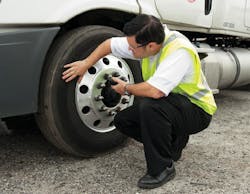NASHVILLE. Michelin Americas Truck Tires introduced a new service this week here the 2015 Technology & Maintenance Council (TMC) annual meeting; a digital tire monitoring and reporting service that aims to reduce road service calls, improve Compliance Safety Accountability (CSA) scores, maximize fuel economy and increase tire mileage.
The program – called Michelin Tire Care – is split into two different offerings, noted Vic Koelsch, COO for Michelin Americas Truck Tires division:
- Fleet Ready provides regular tire monitoring for air pressure, tread depth, valve caps, irregular wear, plus a full visual inspection scheduled at a pre-determined frequency chosen by the fleet – information compiled into summary reports that will highlight immediate needs and project tire replacement. This service will cost $15 per inspection, he noted.
- Fleet Fit takes the Fleet Ready offering a step further by adding tire selection guidance by wheel position and application, tire forecasting, budgeting and tire optimization by vehicle. This next level of service will cost about $20 per tire inspection, Koelsch said.
- Both of the above options also get access to Michelin’s Road Ready service, which provides over-the-road tire monitoring via the TIREPASS fuel lane service at Love’s Travel Stops.
“It’s really about taking data and turning it into information for fleets,” Koelsch explained during a press conference here at TMC’s yearly convention, adding that Michelin expects to deploy some 3,500 digital tire monitoring devices nationally through this program by the end of the first quarter; devices that will gather data on some 1.5 million truck tires this year.
Right now the program is limited to fleets operating in the U.S., but he said that Michelin plans to expand it eventually into Canada and Mexico. “We’re especially getting a lot of interest from fleets operation on the southern U.S. border,” Koelsch pointed out.He added that Michelin has performed such tire monitoring services for years, but adding digital technology changes things completely.
“With digital technology we can gather tire data in two and half minutes and provide it to fleets in real time, versus manual processes that might take days or weeks to deliver information to a fleet,” Koelsch noted. “This [program] is also an interim step as we move to a more automated system of gathering tire data.”
He added that the program is designed to capture in part data on six key truck tire factors: low air pressure, high air pressure, missing valve caps, mismatched air pressure, mismatched tire height, and irregular tire wear.
Obtaining and analyzing such data in real time then allows fleets to get ahead of potential tire-related programs that might result in vehicle downtime.
And Koelsch noted that industry research indicates that 1.5 tire-related downtime events currently occur per vehicle per year in trucking.
“Eventually we’ll be talking about offering guarantees here due to our data analysis; guarantees regarding increased vehicle uptime, improved fuel economy, and improved CSA scores,” he pointed out.
Michelin Tire Care – which began pilot testing in September last year – becomes the “third leg” of the Michelin Commercial Service Network, launched back in 2010; joining the company’s Michelin ONCall 2.0 expanded emergency road service program and Michelin Truck Care preventative maintenance offering.
Koelsch said that to date 30 fleets have joined the new Michelin Tire Care program and not all of them Michelin tire customers. “We will also eventually be able to offer benchmarking services to customers based on the [tire] data we’re gathering,” he said.




